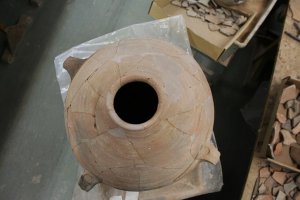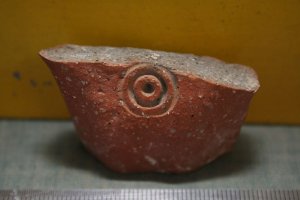
Earth’s Mysterious Magnetic Field, Stored in a Jar

Of all the environmental amenities that this hospitable planet provides, the magnetic field is perhaps the strangest and least appreciated. It has existed for more than three and a half billion years but fluctuates daily. It emanates from Earth’s deep interior but extends far out into space. It is intangible and mostly invisible—except when it lights up in ostentatious greens and reds during the auroras—but essential to life. The magnetic field is our protective bubble; it deflects not only the rapacious solar wind, which could otherwise strip away Earth’s atmosphere over time, but also cosmic rays, which dart in from deep space with enough energy to damage living cells. Although sailors have navigated by the magnetic field for a millennium and scientists have monitored it since the eighteen-thirties, it remains a mysterious beast. Albert Einstein himself said that understanding its origin and persistence was one of the great unsolved problems in physics. Today, the scientific consensus is that the field arises in Earth’s outer core, where the movement of liquid iron creates a giant, self-perpetuating electromagnetic dynamo, and that the geometry of the field is approximately dipolar, like a bar magnet, with the two ends coinciding, on average, with the geographic North and South Poles.
In detail, however, things are much messier. The global magnetic field also has quadrupole and octopole components, which make its actual geometry something like a playground jack with extra spikes. The strength and orientation of the field can change without warning, over millions of years or in a few days. Since 1990, the magnetic North Pole has migrated almost nine hundred miles, from Axel Heiberg Island, in the high Canadian Arctic, to a site close to the true North Pole. At the same time, the over-all intensity of the field has been falling at a rate of about six per cent each century. Changes like this do not always happen steadily; since 1969, there have been four well-documented “geomagnetic jerks,” in which the rate of change in the field strength abruptly accelerated before, months later, settling back to normal.
Direct measurements of the magnetic field now span almost two hundred years, and iron-rich volcanic rocks on the ocean floor provide a lower-fidelity chronicle of its erratic behavior—including wholesale reversals in polarity—back about a hundred and fifty million years. But reconstructing the field’s behavior between these two extremes has been difficult. The trick is to find an iron-bearing object that locked in a record of the magnetic field at a well-constrained time in the past, in the way that wine of a given vintage preserves an indirect record of that year’s weather conditions. For this sort of remnant magnetism to form, the object generally must have been heated and then cooled through its Curie temperature—the threshold, named for Pierre, at which iron-oxide particles will align themselves with the ambient magnetic field. At best, however, young volcanic rocks can only be dated to within a few thousand years. Fortunately, natural rocks aren’t the only ones with magnetic memories; archeological materials like fired pottery and even smelting slag may bear similar information. On Monday, in a study published in Proceedings of the National Academy of Sciences, a team of Israeli and American archeologists and geophysicists reports the most detailed reconstruction yet of the magnetic field in pre-instrumental times, using a set of ceramic jars from Iron Age Judea.

The clay jars, which were likely everyday vessels for wine or olive oil, do not appear to have been made with particular care. Although they exist now as fragments, they can be dated with unusual confidence because of the royal insignias stamped on their handles; they were made between 750 and 150 B.C. The team’s analysis suggests that for much of that time the magnetic field was relatively stable, and about forty per cent stronger than it is now. But the oldest jars reveal that, just before 700 B.C., the field’s strength briefly jumped by half, to almost twice its modern intensity, then fell rapidly in the next three decades. Today, such an event would cause catastrophic disruption of the electrical grid and satellite communications. It’s unlikely that the Judeans even noticed it.
The new findings, with their clear evidence of a geomagnetic spike, may help archeologists date pottery from other Iron Age sites, particularly where stamps are lacking. The study could also be useful in a second, less direct way. Carbon-14, the isotope that archeologists use in radioactive dating, is cosmogenic—continuously created in Earth’s uppermost atmosphere by cosmic-ray collisions. As a result, its rate of production fluctuates with the strength of the magnetic field. At times when the field is weak, more 14C is produced, and organic materials (wood, peat, seeds, textiles) soak up more of it than usual, making them seem younger. When the field is strong, the same materials’ ages will skew old. By understanding the past dips and rises of the magnetic field, archeologists can reduce the uncertainties in their calculations.
But, in the geophysical community, the tales told by the Judean jars may cause unrest. Both the height and the sharpness of the spike they recount push up against the limits of what some geophysicists think Earth’s outer core is capable of doing. If the eighth-century-B.C. geomagnetic jeté is real, models for the generation of the magnetic field need significant revision. Given the importance of a stable magnetic field to our electricity-dependent, communications-obsessed culture, these questions are of more than academic interest. The makers of these old jars, diligently stamping handles with the royal brand, had no idea that they were contributing to a twenty-first-century debate about the very heart of the planet. One wonders what unintentional messages the objects we leave behind will carry into the future.
Marcia Bjornerud is a professor of geology at Lawrence University, in Appleton, Wisconsin, and the author of “Reading the Rocks: The Autobiography of the Earth.”
###
The research was supported by the United States–Israel Binational Science Foundation (Grant 2012359 to E.B.-Y. and L.T.) and National Science Foundation Grant EAR-1345003 (to L.T.).
View original article